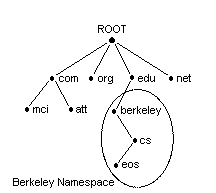A DNS domain includes all compouters and resources that fall under a particular part of the Domain Name System hierarchy, called a namespace. For instance, the domain name inetdaemon.com would be used for all computer names and resources that belong to InetDaemon. Basically, a domain name is used as the identifier for a group of computers that as far as DNS is concerned are all part of the same group. All the computers at the University of Berkeley in California would fall under berkeley.edu.
Valid Domain Names
Domain Names as supported in the Domain Name System must be less than 63 characters in total length, begin and end with a letter or number, and can contain only lowercase letters, numbers and the hyphen character (the hyphen '-' must be in the middle somewhere). Letters in any domain name are always lowercase. Underscores are not valid, nor are special characters like the @, or & symbols.
WARNING: The underscore character is not a valid character in DNS. Microsoft DNS zones contain zones with underscores. When Microsoft Active Directory integrated DNS servers are used as DNS servers, zone transfers to non-Microsoft serers (the majority of the Internet) will fail. There are also significant security risks in using Active Directory integrated DNS servers as Internet DNS servers.
Fully Qualified Domain Names
 Fully
qualified domain names (FQDNs) are names that have been spelled out all the
way to the root of the DNS hierarchy. Look at the example DNS hierarchy diagramto
the right. The true, fully qualified domain name for the host eos would
be eos.cs.berkeley.edu. (note the trailing dot after the edu in
the name). Most DNS resolvers are smart enough not to need the last dot and
it is assumed to be there; however, when troubleshooting domain name service
issues with applications such as nslookup, its a good idea to use
the period at the end to make sure the local computer doesn't add on additional
domain name information that isn't necessary.
Fully
qualified domain names (FQDNs) are names that have been spelled out all the
way to the root of the DNS hierarchy. Look at the example DNS hierarchy diagramto
the right. The true, fully qualified domain name for the host eos would
be eos.cs.berkeley.edu. (note the trailing dot after the edu in
the name). Most DNS resolvers are smart enough not to need the last dot and
it is assumed to be there; however, when troubleshooting domain name service
issues with applications such as nslookup, its a good idea to use
the period at the end to make sure the local computer doesn't add on additional
domain name information that isn't necessary.
The root domain's zone file contains entries for all the servers that handle .com, .org, .edu and so on. The servers that manage .edu have an entry for berkeley.edu domain. The Berkeley nameserver has a record for the nameserver in the cs.berkeley.edu. domain. The nameserver for the cs.berkeley.edu domain will have the host record (an 'A' resource record) for the host named eos.
« Back to Main DNS Tutorial | Domain Names | Domain Name Registration | Shared Domain Registration System | Domain Name Resolution »